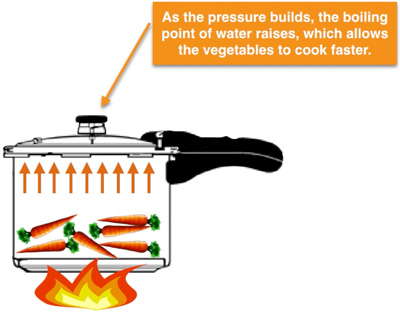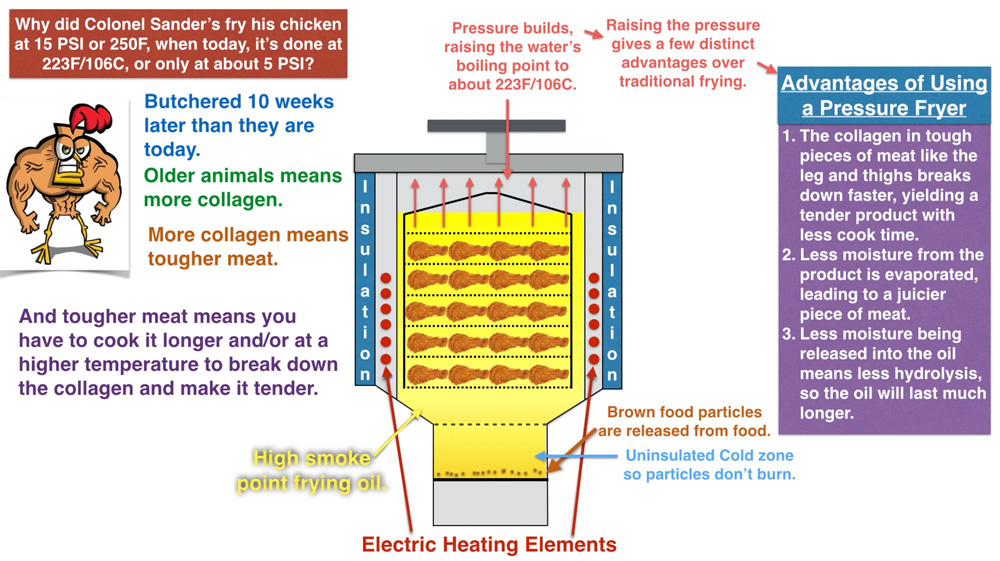Have you ever wonder how fried chicken joints like KFC, Popeye's, and Chick-fil-A create a consistent product that's juicy and tender?
Part of their secrete lies in a specialty piece of equipment called a pressure fryer.
The pressure frying story begins during the great depression, with a man named Harland Sanders selling his southern fried chicken at a roadside stand in Corbin, Kentucky. He eventually made enough money to open up his own brick-and-morter restaurant, where his fried chicken amassed a fairly large and loyal following.
But even with his success, Mr. Sanders had one major issue; his southern fried chicken took 35 minutes to cook from start to finish.
With the classic, southern fried chicken technique, a cast iron pan or dutch oven is filled with a shallow amount of cooking oil, usually just enough to cover the bottom and the sides of the product being fried. The chicken is placed in the hot oil, flipped once, twice, maybe a few times depending on the cook, until it's golden brown on all sides and fully cooked through.
This is in contrast to deep fat frying, in which the chicken is fully submerged in hot oil, allowing it cook faster, but an approach Mr. Sanders felt was far inferior to chicken fried in the classic southern style.
 Sanders eventually discovered a novel solution to his problem when he attended a pressure cooking demonstration. The demonstrator explained that a tight fitting lid is applied to the pot, and when the pressure builds, the boiling point of any water based liquid contained in the pot will rise, allowing the vegetables to cook faster.
Sanders eventually discovered a novel solution to his problem when he attended a pressure cooking demonstration. The demonstrator explained that a tight fitting lid is applied to the pot, and when the pressure builds, the boiling point of any water based liquid contained in the pot will rise, allowing the vegetables to cook faster.
After seeing the demonstration, Sanders thought he could apply this same concept to his southern fried chicken, allowing it to not only cook faster, but possibly even end up with a better end product.
So Sanders hit the drawing board and came up with a rough working model for pressure frying chicken--his first pressure fryer was in fact a modestly tweaked version of a standard pressure cooker.
In his new, novel approach which sanders coined "pressure frying," he would start by heating cooking oil to 350-400F/176-204C in the base of a pressure cooker. Enough chicken was placed in the hot oil to allow rapid browning, while simultaneously dropping the oils temperature to around 250-275F/121-135C. The pot was sealed with a lid, and pressure was allowed to build to 15 PSI, causing water's boiling point to be raised from 212F/100C (at sea level) to 250F/121C.
Once pressure was achieved, the chicken was cooked through, which took about 8 minutes according to Sanders initial patent filing.
The pot was then vented, the chicken drained, and served.
 However, this method had one major pitfall -- using a modified pressure cooker for frying was extremely dangerous. The seals could fail, pressure could build too rapidly, and there are even stories of pressure fryers blowing up in the early days of their use (no note on the casualties though).
However, this method had one major pitfall -- using a modified pressure cooker for frying was extremely dangerous. The seals could fail, pressure could build too rapidly, and there are even stories of pressure fryers blowing up in the early days of their use (no note on the casualties though).
Sanders decided to finance the development of a commercial pressure fryer, and Winston Shelton submitted the winning design. This new piece of technology, along with a Sanders' secretive eleven herbs and spices blend, spawned the culinary fast food giant Kentucky Fried Chicken, making Sanders a wealthy man, and most importantly, earning him the honorary title of Kentucky Colonel, which he attached to his name for the rest of his life.
As for Winston Shelton, his company Winston Industry became famous for the "Collectramatic" pressure fryer that is still manufactured and sold today, and would later become a hero to fast food chains and fine dining chefs alike for his invention of the C-VAP water oven.
How Does Pressure Frying Work?
 Pressure frying works by increasing the atmospheric pressure inside the enclosed fryer. Increased atmospheric pressure causes the boiling point of water, in this case the liquid in the fried chicken, to rise. This has a couple of effects.
Pressure frying works by increasing the atmospheric pressure inside the enclosed fryer. Increased atmospheric pressure causes the boiling point of water, in this case the liquid in the fried chicken, to rise. This has a couple of effects.
First, when any product is dropped into hot oil for deep frying, the moisture at the surface quickly heats to the boiling point, causing it to evaporate as steam. This is why aggressive bubbling is seen in the early stages of frying.
But because so much steam is enveloping the fried food during the cooking process, the steam will initially act as a temperature buffer, creating a zone small zone around the product that will initially however around 212F/100C, the maximum temperature of steam at sea level.
Yet when pressure is allowed to build in the fryer, the temperature of the steam will also rise, and because it's in direct contact with the surface of the protein being fried, the protein will arrive at its finished internal temperature much faster.
Second, because the boiling point of water is raised under pressure, less of the protein's liquid (juices) turn to steam in a pressure cooker, leading to more moisture retention, and a juicier end product.
Finally, because less water is released during the frying process, the oil will actually last longer. This is because water will cause hydrolysis in oil at temperatures above 300F/149C (Chemistry of Deep-Fat Frying Oils). Hydrolysis breaks down the fatty chains that make up the frying oil, and part of the byproduct of this reaction is the formation of free form fatty acids. The more free form fatty acids an oil or fat contains, the lower it's smoke point will be.
Why Modern Pressure Fryers Cook at a Lower Temperature
If you read through Colonel Sanders' original US patent filing, he explains that after his chicken was browned, it would be cooked at 15 PSI, or 250F/121C (the boiling temperature of water under fifteen pounds of pressure per square inch at sea level).
But with modern pressure fryers, chicken is usually cooked at around 5 PSI, or only 223F/106C.
This is because in 1966 when Colonel Sanders developed his pressure frying technique, the chickens were much tougher; they were butchered 10 weeks older than the chickens we consume today.
Older chickens means more collagen (chewy connective tissues), which means a longer cook time and/or a higher temperature is necessary to make the chicken tender.
Related Resources
There are 12 Comments

Here's an audio response.
Here's an audio response. Sorry Robsous, but I didn't see your question till after I hit record. Will answer tomorrow.

The boiling point of water in
The boiling point of water in a pot is limited by atmospheric pressure. This means there is a limit to how hot something can get without being pressurized. Now if the boiling point of water is raised, there's more heat, which means things cook faster.
The collagen in chicken wings starts to break down at a temperature far below boiling (155F). So when a chicken wing or anything else is cooked under pressure, the "heat limit" of boiling water is raised, allowing the product to cook faster than normal.
If too much collagen breaks down, you get a mushy wing.
@ J..weinstein,
Breadings are for flavor and texture, and/or to provide a protective coating to something without skin (fish, vegetables, whatever). If you were getting good results at KFC with a 6 minute fry, then that sounds like a good starting point for testing. I understand how pressure fryers work, but I don't have one at my disposal, so I can't test any or your ideas, which I would need to do to give you a definitive answer.
The best thing I can suggest is to do some testing on your end with the pressure fryer, and I can help you explain the science behind your results, which can inform future tests and procedures.
